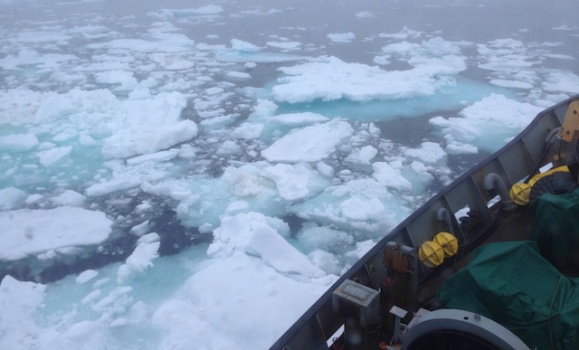News
» Go to news mainLabrador Sea Cruise Report: Estimating the Anthropogenic Carbon Inventory

From the 30th of April until the 24th of May 2016, CERC.OCEAN PhD student Lorenza Raimondi was on a research cruise across the Labrador Sea on board the CCGS Hudson. The expedition was part of the Atlantic Zone Off-Shelf Monitoring Program (AZOMP - http://www.bio.gc.ca/science/monitoring-monitorage/azomp-pmzao/azomp-pmzao-en.php) run by scientists from the Bedford Institute of Oceanography (BIO). Despite the rough weather, Lorenza was able to collect samples for the carbonate chemistry parameters investigation (Total Alkalinity, Dissolved Inorganic Carbon, pH, and Partial Pressure of Carbon Dioxide). This cruise was, together with the 2014 and 2015 cruises, a fundamental step for Lorenza’s PhD project; she collected samples across the whole Labrador Sea basin adding new data to the unique dataset that scientist from BIO have been developing since the early 90’s along a transect known as AR7W line. Together with scientists from BIO, Lorenza spent time on the ship with researchers from the VITALS Program (Ventilation, Interactions and Transport Across the Labrador Sea - http://knossos.eas.ualberta.ca/vitals/), of which she is part of, and which aims at understanding how deep convection in this area affects exchanges in carbon, oxygen, and heat with the atmosphere .
The Labrador Sea is an important region of water masses vertical transport that represents a direct communication between deep ocean and atmosphere. Therefore, its role is critical to deeply understand the forcing factors that control the distribution of gasses, as Carbon Dioxide (CO2) and Oxygen (O2), in the ocean. Presently the Labrador Sea is described as a sink of atmospheric carbon dioxide, and consequently of anthropogenic CO2 (Cant), in particular during severe winters when vertical convection is intensified. Nevertheless there might be fluctuation of these trends according to seasonal cycles and interannual variability. Lorenza's research develops on this framework and focusses on understanding the carbon cycle in this region on a long-term perspective and aims at detecting and quantifying the signal of anthropogenic carbon using several indirect techniques. This will help in understanding the uptake, storage and transport of Cant and therefore determining the role of Labrador Sea on the global carbon budget.
A huge thanks goes out to all of the crew members of the CCGS Hudson that allowed us to collect samples in all weather conditions, the AZOMP, Kumiko Azetsu-Scott (Lorenza’s supervisor from BIO), Doug Wallace (CERC.OCEAN) and last but not least to Stephen Punshon for the great help and support provided both during the cruise and in the laboratory.
Some of the weather was a little rough! Check out this video to see some of the conditions experienced during this cruise. (Video by Mitchell Wolf from the University of Victoria)
Recent News
- Recap of ASITA 2024 Conference
- ASITA 2024 Conference
- Happy World Ocean Day! + CMOS congress 2023 recap
- Upcoming presentations by CERC.OCEAN lab at the CMOS 57th congress
- UPDATED: List of Instrumentation and Analytical Services
- Field Report: Exploratory Study of nitrogen cycling at the Lagoon Lagos
- Marine Robots – Back in Action at OHMSETT
- Spotlight of the month: Adriana Reitano

